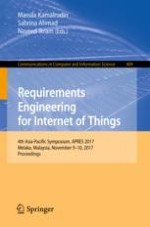2018 | Book
Requirements Engineering for Internet of Things
4th Asia-Pacific Symposium, APRES 2017, Melaka, Malaysia, November 9–10, 2017, Proceedings
Editors: Massila Kamalrudin, Sabrina Ahmad, Naveed Ikram
Publisher: Springer Singapore
Book Series : Communications in Computer and Information Science
